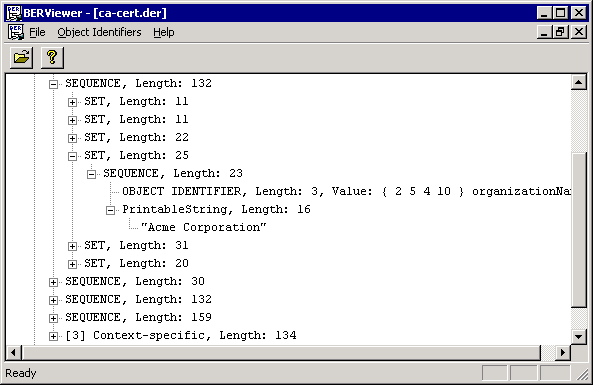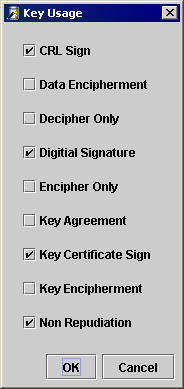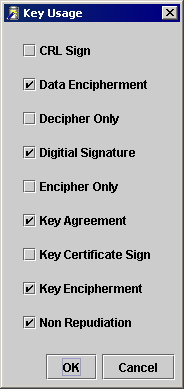7.18.1 Introduction to Certificates
What is a Certificate?
A certificate is a public key labeled with information to identify its owner (Subject Name) and to control its use.
What is self-signed certificate?
A self-signed certificate is one for which the Issuer Name (signer) is the same as the Subject Name (owner).
What makes a certificate a CA certificate?
When it is used to issue other certificates.
It also contains information (extensions) that support its roles of issuing certificates (CRLDistPoint, BasicConstraints etc...)
It should also contain the BasicConstraints extension with the CA flag set to true.
Root or top-level CA certificates are self-signed.
What is the certificate thumbprint
The certificate thumbprint is a hash calculated on the whole certificate.
This thumbprint is calculated every time a certificate is displayed - it is not contained in the certificate.
What goes into a Certificate?
The X.509 standard defines what information can go into a certificate, and describes how to write it down (the data format).
All X.509 certificates have the following data, in addition to the signature:
|
Versions
Version 1 has been available since 1988, is widely deployed, and is the most generic.
Version 2 introduced the concept of subject and issuer unique identifiers to handle the possibility of reuse of subject and/or issuer names over time. Most certificate profile documents strongly recommend that names not be reused, and that certificates should not make use of unique identifiers. Version 2 certificates are not widely used.
Version 3 is the most recent (1996) and supports the notion of extensions, whereby anyone can define an extension and include it in the certificate.
Some common extensions in use today are:
- KeyUsage (limits the use of the keys to particular purposes such as "signing-only")
- AlternativeNames (allows other identities to also be associated with this public key, e.g. DNS names, email addresses, IP addresses)
Extensions can be marked critical to indicate that the extension should be checked and enforced/used.
For example, if a certificate has the KeyUsage extension marked critical and set to "keyCertSign" then if this certificate is presented during SSL communication, it should be rejected, as the certificate extension indicates that the associated private key should only be used for signing certificates and not for SSL use.
Encoding Format
All the data in a certificate is encoded using two related standards called ASN.1/DER. Abstract Syntax Notation 1 describes data. The Definite Encoding Rules describe a single way to store and transfer that data.
In the X.500, X.509 and X.520 standards the structures are specified with Abstract Syntax Notation 1 (ASN.1) and are encoded for transport using the Basic Encoding Rules (BER) that encode ASN.1 as 8-bit binary data.
In addition, when they represent data to be signed, as they do within certificate management, the signature is calculated on the data encoded using Distinguished Encoding Rules (DER: a subset of BER which has the property that the same data always encodes to the same binary representation).
Information stored in a certificate is a sequence of ASN.1 Objects each labeled with an object Identifier (OID).
An object identifier is a string of numbers identifying a unique object, for example, a certificate extension or a company's certificate practice statement.
OIDs are controlled by the International Standards Organization (ISO) registration authority.
In some cases, this authority is delegated by ISO to regional registration authorities.
The OID is a unique sequence of hierarchical numbers in a dot notation.
Top level OID assignments:
|
0 |
ITU-T assigned |
|
|
|
1 |
ISO assigned |
|
|
2 |
Joint ISO/ITU-T assignment |
Secondary level assignments:
|
2.5 |
X.500 Directory Services |
Other level assignments:
|
2.5.4 |
Object Identifiers for X.500 attributes type |
|
|
|
2.5.4.3 |
Common Name |
|
|
2.5.4.5 |
Serial Number |
|
|
2.5.4.6 |
Country Name |
|
|
2.5.4.7 |
Locality |
|
|
2.5.4.8 |
State |
|
|
2.5.4.10 |
Organization |
|
|
2.5.4.11 |
Organizational Unit |
|
2.5.29 |
Object Identifiers for Version 3 extensions |
|
|
|
2.5.29.14 |
Subject Key Identifier |
|
|
2.5.29.15 |
Key Usage |
|
|
2.5.29.17 |
Subject Altervative Name |
|
|
2.5.29.19 |
Basic Constraints |
|
|
2.5.29.35 |
Authority Key Identifier |
Certificate viewed using a generic BER viewer:

Critical and Non-critical extensions
If an extension is critical it can only be used for the purposes indicated.
If an extension is non-critical it is an advisory field and not restrictive.
|
Standard CA Key Usage Dialog:
|
Standard Certificate Key Usage Dialog:
|
Key Usage
The critical key usage extension controls how the public key can be used.
RFC 2459 Internet X.509 Public Key Infrastructure Certificate and CRL Profile describe the role of the different key usage extensions bits.
CRL Sign is enabled when the public key is used for verifying a signature on a CRL. Enable for CA certificates.
Data Encipherment is enabled when the public key is used for enciphering user data, other than cryptographic keys.
Decipher Only and Key Agreement are enabled, when the public key is being used only for deciphering data while performing key agreement.
Digital Signature is enabled when the public key is used with a digital signature mechanism to support security services other than non-repudiation, key certificate signing, or CRL signing. Enable for SSL client certificates and S/MIME signing certificates.
Encipher Only and Key Agreement are enabled, when the public key is being used only for enciphering data while performing key agreement.
Key Agreement is enabled when the public key is used for key agreement.
Key Certificate Sign is enabled when the public key is used for verifying a signature on certificates. Enable for CA certificates.
Key Encipherment is enabled when the public key is used for key transport. Enable for SSL server certificates and S/MIME encryption certificates.
Non Repudiation is enabled when the public key is used to verify digital signatures. Enable for S/MIME signing certificates and object-signing certificates.

